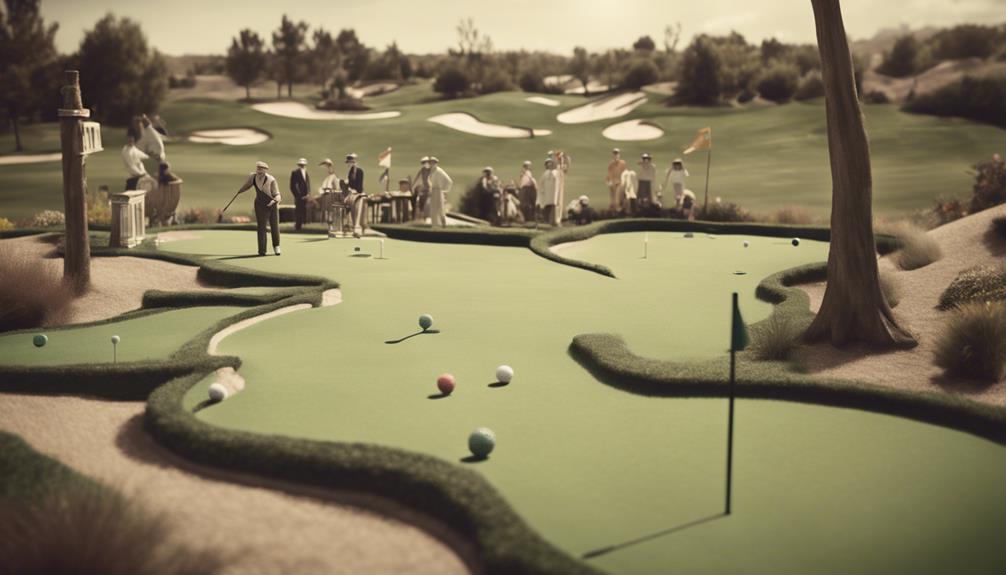- 7 Top Flite Golf Clubs XL for Improved Performance - September 28, 2024
- Top Flite Golf Clubs: Top 5 Reasons to Choose Them - September 28, 2024
- Top 3 Golf Club Fitters for a Perfect Swing - September 28, 2024
You're likely familiar with traditional golf's sprawling greens, but mini golf offers a distinct alternative, swapping sprawling landscapes for compact, whimsical courses that cater to a broader range of players and priorities. Mini golf's smaller footprint reduces environmental costs, and its accessibility accommodates players of all skill levels, focusing on putting without need for extensive knowledge of rules or etiquette. With lower costs, social interaction, and a casual atmosphere, mini golf promotes inclusivity for newcomers, while traditional golf requires practice to improve scores, limiting accessibility. As you explore these differences, you'll uncover more nuances that set these two golfing experiences apart.
Key Takeaways
- Standard golf courses span 100 acres, while mini golf courses occupy only 1-2 acres, reducing environmental impact.
- Mini golf is more accessible to players of all skill levels, focusing on putting and requiring minimal knowledge of rules or etiquette.
- Mini golf is significantly cheaper, costing less than $10 per player, compared to standard golf's average of $50 for 18 holes.
- Mini golf courses feature whimsical obstacles and decorative elements, unlike traditional golf's natural obstacles, making it a more recreational experience.
Size and Environmental Impact
When you step onto a standard golf course, you're likely to be surrounded by expansive landscapes spanning around 100 acres, a stark contrast to the compact 1-2 acres occupied by mini golf courses.
This significant difference in size has a profound impact on the environment. Traditional golf courses require substantial water consumption for upkeep, whereas mini golf courses need substantially less water and maintenance, making them a more eco-friendly option.
The construction and landscaping of standard golf courses also have high environmental costs, whereas mini golf's smaller footprint results in a reduced ecological impact.
Mini golf courses often incorporate artificial features that minimize natural resource consumption, unlike traditional golf courses that rely on natural elements. The compact design of mini golf courses further reduces their environmental impact, requiring fewer resources for maintenance and overall management.
As you consider playing golf and mini, it's important to recognize the significant difference in size and environmental impact between these two options.
Accessibility and Skill Levels
As you weigh the differences between golf and mini golf, another key consideration is the vastly different accessibility and skill levels required to participate in each game.
When it comes to accessibility, mini golf is the clear winner, offering a fun activity that can be enjoyed by people of all ages and skill levels.
Here are some key differences:
- Skill levels: Mini golf allows players of all skill levels to compete equally, focusing on putting rather than complex techniques, whereas standard golf requires varying skill levels and experience.
- Accessibility: Mini golf is more accessible, with no need to understand rules, techniques, and etiquette, making it a great option for families and groups looking for a recreational activity.
- Competition: In standard golf, handicaps are used to level the playing field, making competition more complicated, while mini golf has no such system, simplifying gameplay.
Cost Comparison and Fun Factor

How much does it cost to tee off, and will you have more fun doing it? When it comes to cost comparison, mini golf is the clear winner. You can expect to pay less than $10 per player for a round of mini golf, whereas standard golf typically costs around $50 for 18 holes. This makes mini golf a more financially accessible option for families and larger groups. The lower cost also means you can play more frequently, making it a great choice for community participation and social gatherings.
The fun factor is also an essential consideration. Mini golf offers a casual atmosphere that promotes enjoyment and social interaction, appealing to a broader audience, including families and beginners. The whimsical and themed obstacles add to the recreational experience, providing a unique entertainment option compared to traditional golf.
With an average round lasting around 45 minutes, mini golf requires a shorter time commitment, making it an ideal activity for the whole family. So, if you're looking for an affordable and entertaining option that's perfect for all ages, mini golf is the way to go.
Gameplay and Course Design
With respect to gameplay and course design, standard golf and mini golf diverge considerably, with distinct features that cater to different playing styles and preferences.
Here are some key differences:
- Course layout: Standard golf courses feature 18 holes with varying distances, while mini golf courses consist of 18 holes that are only a few meters apart, designed for quicker play.
- Obstacles: Traditional golf utilizes natural obstacles like trees and hills, whereas mini golf incorporates decorative and whimsical obstacles like windmills and tunnels to enhance visual appeal and challenge.
- Game duration: A round of mini golf usually takes about 45 minutes to complete, compared to approximately 4 hours for a round of traditional golf, making mini golf a more time-efficient option.
These differences in gameplay and course design contribute to distinct experiences for players, making mini golf an attractive option for those seeking a faster-paced, more accessible game.
History and Evolution of Mini Golf

Mini golf's humble beginnings date back to 1912, when the first recorded game marked the sport's emergence as a scaled-down version of traditional golf, paving the way for its evolution into a distinct recreational activity. As you explore the history of mini-golf, you'll find that it gained significant popularity in North Carolina, particularly with the establishment of the Putt-Putt Fun Center in 1954. This center trademarked the name and set branding standards, playing a vital role in commercializing and standardizing mini-golf.
Here's a snapshot of mini-golf's evolution:
| Year | Milestone | Impact |
|---|---|---|
| 1912 | First recorded mini-golf game | Emergence as a scaled-down version of traditional golf |
| 1954 | Establishment of Putt-Putt Fun Center | Commercialization and standardization of mini-golf |
| Late 20th century | Introduction of whimsical and thematic courses | Shift towards family-friendly recreational activity |
| Late 20th century | Solidification as a family-friendly recreational activity | Appeal to a diverse audience and casual competition |
As mini-golf continued to evolve, it moved away from traditional golf's natural elements, incorporating fun and decorative features to create whimsical courses. By the late 20th century, mini-golf had solidified its status as a family-friendly recreational activity, appealing to a diverse audience and fostering casual competition.
Frequently Asked Questions
Is Mini Golf the Same as Regular Golf?
You'll find that mini golf deviates from regular golf in golf techniques, scoring systems, equipment differences, course layouts, and player experience, making it a distinct, more casual, and accessible alternative that's perfect for a quick, fun outing.
What's the Difference Between Crazy Golf and Mini Golf?
You'll notice that crazy golf courses boast whimsical obstacles, prioritizing entertainment, while mini golf courses balance fun and challenge with themed designs, varied gameplay mechanics, and scoring systems, offering a distinct experience.
Why Do People Play Mini Golf?
You play mini golf to foster family bonding, tap into your competitive spirit, and enjoy outdoor fun, all while experiencing stress relief and subtle skill development, making it an engaging activity that's hard to resist.
What Is Mini Golf Also Known As?
You'll find that mini golf is also known as miniature golf, putt-putt, crazy golf, or simply a recreational activity that combines family entertainment with themed obstacles, requiring unique putting techniques on smaller, imaginative courses.
Conclusion
You've now grasped the key differences between golf and mini golf.
From size and environmental impact to accessibility, cost, and gameplay, each sport has its unique characteristics.
Curiously, according to the International Miniature Golf Association, there are over 12,000 mini golf courses worldwide, with the US boasting more than 3,000 alone.
Whether you're a seasoned golfer or a casual player, both sports offer enjoyable experiences, so grab your clubs and get ready to tee off!




